Naturalist’s Notebook – May 28, 2016 to June 03, 2016
The weather was cited by both naturalists on May 28 as a major reason for the enjoyment of their passengers. Spring sunshine and a warm breeze from the southwest added to the gentle seas to make this day a complete pleasure on the water. Add to that weather three species of feeding whales and what you get are very excited passengers. The passengers of the Dolphin VIII found the southern edge of Stellwagen Bank a diversely productive area. Thick schools of sand eels drew loads of herring gulls to the area. And, amid the dropping of these gulls to the water for a beakful of fish, there were also multiple charging Minke whales and a juvenile Humpback buzily feeding just below the surface.
There was a sudden rush of what looked like rain on the water. This was followed by a growing wave that erupted into a Finwhale rolling on its side as it lunged through the closest cloud of schooling fish, exposing the undersides of both its pectoral flipper and fluke to the view of the passengers. The splash that accompanied this whale’s sudden appearance on the surface quickly turned to a pool of green foam as the extended, white underside of the animal dropped beneath the surface for a moment or two before it righted itself for a breath. This was what the passengers of the Dolphin X were treated to after they had been transported to Peaked Hill, southeast of Race Point. Clouds of forage fish, mostly sand launce, had enticed swarms of herring and laughing gulls, mixed with common terns. That forage feast also attracted Minkes, Finback whales, and a Humpback to the early afternoon lunch table.

It was only when the feeding Finwhale righted itself to take a breath that the twin prop scars that gave him his name became visible on his left side. Though unfortunate, the scars on Braid’s side make it easy to identify him in the field. First photographed in 1980, Braid is one of numerous Finbacks that can be recognized because of his scars.
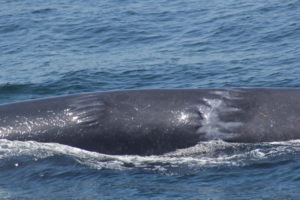
In addition, Nancy Scaglione-Peck added, “We also had a huge gray seal [that was] eating a herring at the surface. It was a lot of work for him to eat such a huge fish. It looked like a striper!”
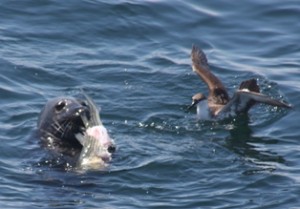
Peaked Hill was also the site of very exciting whalewatches on May 29. Schools of sand eels thick enough to be seen under the bow of the Dolphin X had attracted “tons and tons of herring gulls.” Braid was there again, as was a second Finner. And the juvenile Humpback was also there. And Minke whales. The Dolphin X reports nearly a half dozen on each trip. “Although they are typically more on the shy side, we had a few wonderful close looks at one of them [that] seemed very much interested/curious in our boat. When we went to move on, the Minke began swimming right along side us!” This from Carolyn OConnor.
Her experience seemed to be echoed in the report from the Dolphin VIII. The passengers, and crew too, were stunned as a Minke whale circled the boat repeatedly, rolling over and certainly appearing curious about the vessel. This went on, in the fog, for a full twenty minutes or more, giving passengers and crew amazing looks at a species that is commonly just passed by.
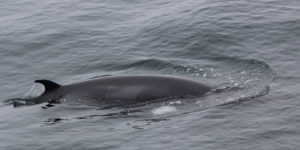
When I talk to the passengers about fluke prints on the boat, I commonly remark that the whalers often used them to track their prey as it swam beneath the surface, kind of like following someone’s footprints on the beach. I never really experienced just how effective this might have been for them until May 30. The mate spotted a Minke whale and our captain took us to where the animal had gone down. After a few minutes, a fluke print was sighted on the surface ahead of us. The Dolphin VIII moved up, gently. Now, a steady line of fluke prints began rising, one after another, all along the port side of the boat. When the whale came up, it was ahead of us again. It, of course, arched high and dove as we got there, but the captain was able to read the new fluke prints as the whale moved beneath the surface and place the vessel beside the animal as it came to the surface.
The whole day saw consistant swells from the east of 3 or 4 feet. What was interesting about the sea today was the way the surface changed repeatedly from glassy to a chop of 3 inches to a foot and a half. The morning fog closed in around the Dolphin VIII as she made her way down the backside toward Peaked Hill. Though not feeding when we got there, Minkes, Finners, and a Humpback were again surrounded by swarms of gulls and shearwaters.
Many times, Finwhales that are feeding are moving way too fast to get a good look. With fuller stomachs, they can afford to move slower. There was enough sunlight coming through the hazy fog that the lower jaw of the animal could be seen as it swam beneath the surface, creating a neon green streak in the water. This was not Braid. The scars were not on the animal’s left side and the dorsal fin was a bit more hooked. But it was still a very large, majestic animal that was moving slowly enough to be appreciated for its size and form. And the very graceful way it slid through the water.
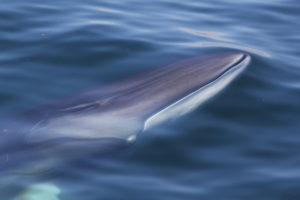

The morning’s fog persisted throughout the day. fell to the surface around lunch time. Asside from the weather conditions, the most interesting sighting from the afternoon’s trip was the ocean sunfish, or Mola mola. The sea, again, was nearly glass and the fish alternated between swimming upright and laying with its left side down. It was one of the passengers that first pointed out that this fish’s right pectoral fin was missing. The missing appendage didn’t appear to inhibit the animal’s movements. Mola’s swim using the fins on their dorsal and ventral sides for propulsion and the pectoral fins for stability and steering. While we were there, it looked like it was quite capable of getting where it wanted to go.
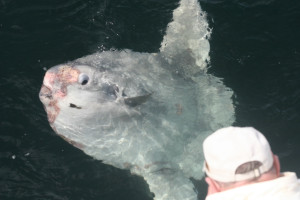
The cloud of gulls that hovered over Peaked Hill on May 31, included Iceland Gulls. Braid was there again. And, today, a whale named Skeg was there as well. Skeg is known to whalewatchers as one of the few Finners that lifts is tail from the water for diving. I don’t want to say the animal does this routinely, but it flukes far more routinely than any other Finner we know. Even when the flukes don’t clear the surface, Skeg arches its back higher and exposes far more of its tail-stalk than more typical Finbacks. Both of these whales are large and make huge splashes when they lunge through the surface while feeding.
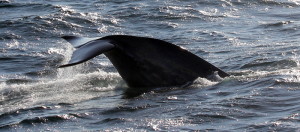
Imagine a body that weighs sixty or seventy tons that can move through water at a speed of thirty or thirty-five knots. When this body is moving at speed, it pushes and displaces a good deal of water but due to its streamlined form, not nearly as much as it should. Think of it kind of as the car commercial where in order to demonstrate how aerodynamic the auto is, a stream of smoke is blown over it. The smoke follows the contour of the hood, rises up along the windshield, and hugs the roof of the car before trailing off behind it. Now think about opening that lower jaw to ninety degrees. Yes, that kind of drag would definately slow down that moving body. But the force of that body’s motion has to go somewhere. When transferred to the water at the surface, it causes an explosion of water to fly above the surface. Sometimes that splash is so big that you cannot see the whale in it.
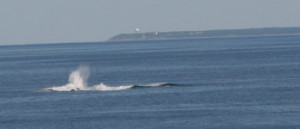
June 1 was yet another three species day down the backside at Peaked Hill. Minke whales, Finback whales, and a Humpback were again feeding beneath a blanket of herring and laughing gulls. The feeding was mostly subsurface during the early part of the day, but as the sun passed its zenith and the tide changed, surface lunging began. Dennis Minksy writes from the Dolphin VIII, “Amazing behavior by a pair of [finbacks], swimming side-by-side and right alongside the boat, giving great looks at their marbled mantles and white cheeks, [and] blowing tall spouts which drifted over the passengers. One even defecated which was also interesting.” I am fairly sure, though, that if the Dolphin VIII were down wind, the passengers would have enjoyed to feel of the spout far more than the scent of the defecation. John Conlon reports, “The absolute most amazing sight of the [afternoon] trip, however, was of 3 Razorbills.” He further comments that while these alcids are frequently seen here in the winter months, sightings after late April are very rare.
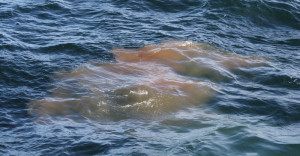
I bet you will never guess where three species of feeding whales were found on June 2. That’s right, Peaked Hill. Today, among the charging Minkes and circling Finners, that juvenile Humpback was joined by several others, some of which were adults like Pregunta. Most of the whales were feeding on thick schools of sand eels beneath the surface, but Pregunta and another began blowing fine nets of bubbles. These thickened into dense clouds that drove the forage fish into even thicker balls for easy consumption by the two Humpbacks. The gulls and shearwaters were making short work of many of the sand eels that managed to escape the open mouths of the whales.
June 3. The past week or so has been so much about feeding whales near Peaked Hill that it was refreshing to read, in addition to the continued melee there, about the three Harbor porpoise that were sighted just inside Long Point. Some nice looks were had at two adults and a “tiny” calf as they wheeled along inside Provincetown Harbor. Mention was also made of the large number of boats seen fishing for bass along the shore between Wood End and Race Pont.





